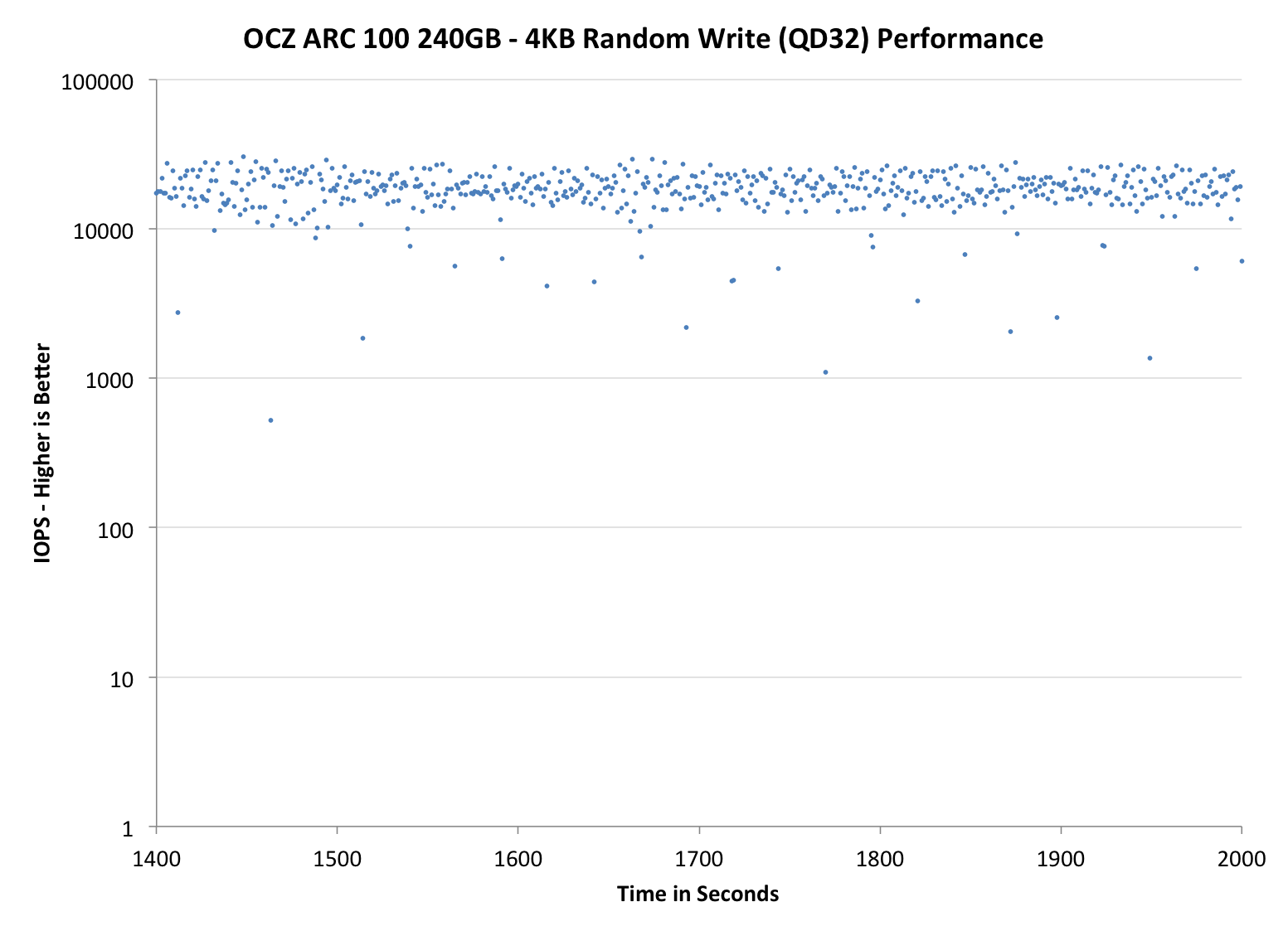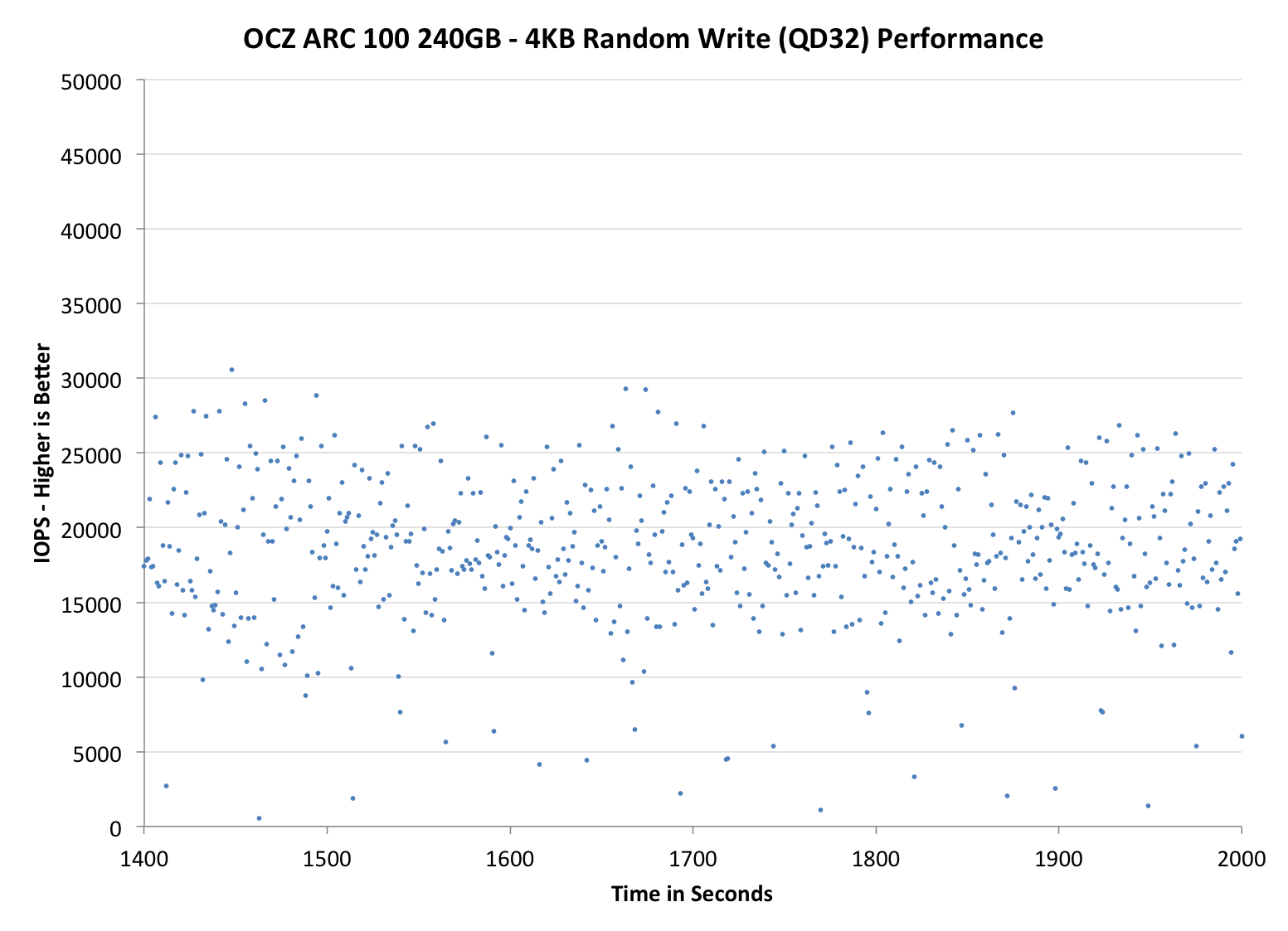OCZ ARC 100 (240GB) SSD Review
by Kristian Vättö on August 26, 2014 7:00 AM ESTPerformance Consistency
Performance consistency tells us a lot about the architecture of these SSDs and how they handle internal defragmentation. The reason we do not have consistent IO latency with SSDs is because inevitably all controllers have to do some amount of defragmentation or garbage collection in order to continue operating at high speeds. When and how an SSD decides to run its defrag or cleanup routines directly impacts the user experience as inconsistent performance results in application slowdowns.
To test IO consistency, we fill a secure erased SSD with sequential data to ensure that all user accessible LBAs have data associated with them. Next we kick off a 4KB random write workload across all LBAs at a queue depth of 32 using incompressible data. The test is run for just over half an hour and we record instantaneous IOPS every second.
We are also testing drives with added over-provisioning by limiting the LBA range. This gives us a look into the drive’s behavior with varying levels of empty space, which is frankly a more realistic approach for client workloads.
Each of the three graphs has its own purpose. The first one is of the whole duration of the test in log scale. The second and third one zoom into the beginning of steady-state operation (t=1400s) but on different scales: the second one uses log scale for easy comparison whereas the third one uses linear scale for better visualization of differences between drives. Click the dropdown selections below each graph to switch the source data.
For more detailed description of the test and why performance consistency matters, read our original Intel SSD DC S3700 article.
 |
|||||||||
| Default | |||||||||
| 25% Over-Provisioning | |||||||||
The performance consistency takes a small hit compared to the Vector 150 and Vertex 460, but compared to the other value drives the ARC 100 offers amazing consistency. Most of the performance gain is due to the higher default over-provisioning (12% vs 7% in other value SSDs), although the Barefoot 3 platform has always done well when it comes to consistency. While there is quite a bit of variation in IOPS, the average is still somewhere between 15K and 20K IOPS, whereas for example the MX100 only provides about 5K IOPS at steady-state.
 |
|||||||||
| Default | |||||||||
| 25% Over-Provisioning | |||||||||
 |
|||||||||
| Default | |||||||||
| 25% Over-Provisioning |
|
||||||||










54 Comments
View All Comments
StevoLincolnite - Tuesday, August 26, 2014 - link
That's true to an extent.I have an OCZ Vertex 2 64Gb SSD which has been fantastically solid for years, if it died and I was able to get it replaced under warranty, I would throw it into a notebook and use the excuse to upgrade the SSD in my main desktop.
That said, the main benefit of an SSD over mechanical that an end-user will notice is not actually the read/write speeds, but rather the 0-latency access times which makes everything feel super snappy and responsive, improved reads/writes are just diminishing returns from an end users experience perspective, hence why I have kept my old Vertex 2 for so long.
hurleydood - Wednesday, December 31, 2014 - link
My old 128GB patriot SSD had a 10 year warranty, failed in 5 years. Patriot replaced it with a latest 240GB SSD they had in inventory. So expect replacements to be current spec.Kristian Vättö - Tuesday, August 26, 2014 - link
Only the 120GB Extreme II is cheaper than the ARC 100 and both have the same 3-year warranty. The Extreme Pro has a 10-year warranty but it is much more expensive.Samus - Tuesday, August 26, 2014 - link
The Extreme II is actually more expensive at all price points except the minimum capacity (120GB) and it isn't always faster, either. The only reason to consider it is for a laptop (where Barefoot 3 makes no sense) if price is a concern.However, I don't see any reason to get anything other than an MX100 for anything except high-performance applications. SleepDev, OPAL, PLP capacitors, solid reliability, lowest price of any SSD at mainstream capacities, and so on...
miandrew - Tuesday, August 26, 2014 - link
Great article. I noticed that the SanDisk Extreme II consistently beats the OCZ ARC 100 and it has slumber power which helps in the laptop world. Nice that Newegg currently has the OCZ sale. So many choices...jerrylzy - Tuesday, August 26, 2014 - link
Why there's no trim validation now?Kristian Vättö - Tuesday, August 26, 2014 - link
I don't usually test TRIM anymore unless we are dealing with a new controller/firmware platform. The Barefoot 3 platform has shown to offer functional TRIM.Witchunter - Tuesday, August 26, 2014 - link
I read this like so: http://i.imgur.com/CMcHBs7.jpg.I agree that there's no need to test it again, but perhaps a reference could be helpful?
Kristian Vättö - Tuesday, August 26, 2014 - link
Haha, a reference sounds like a good idea. I've been trying to streamline the review process to get through my backlog quicker, so that is why it might seem like I'm cutting corners, but I'll take this into account :)Prodromaki - Tuesday, August 26, 2014 - link
Kris, Samsung EVO 256 doesn't cost that much. Its newegg price is 140$. In EU(amazon) for some weird reason MX100 and the EVO are almost the same price(130$ vs 140$). Furthermore the Arc 100 costs ~160$, which definitely makes it a way worse buy than the two other value choices over here.